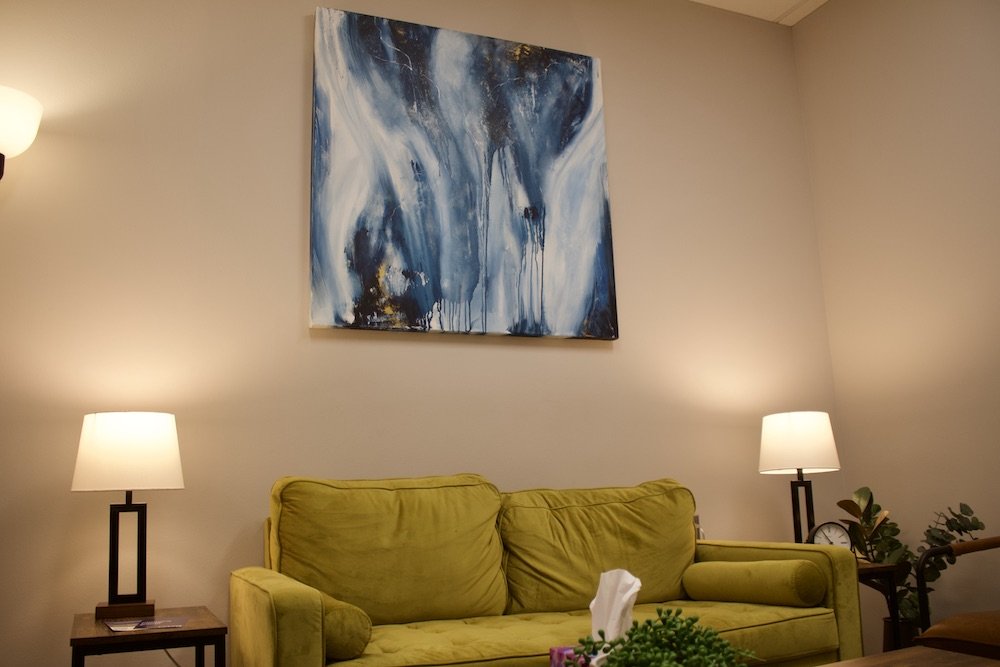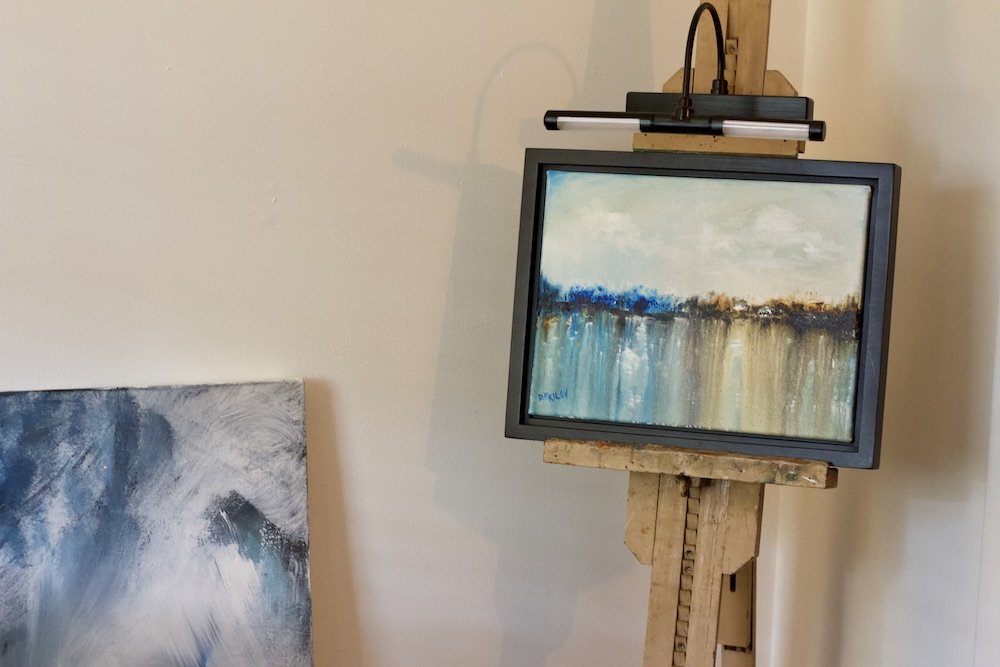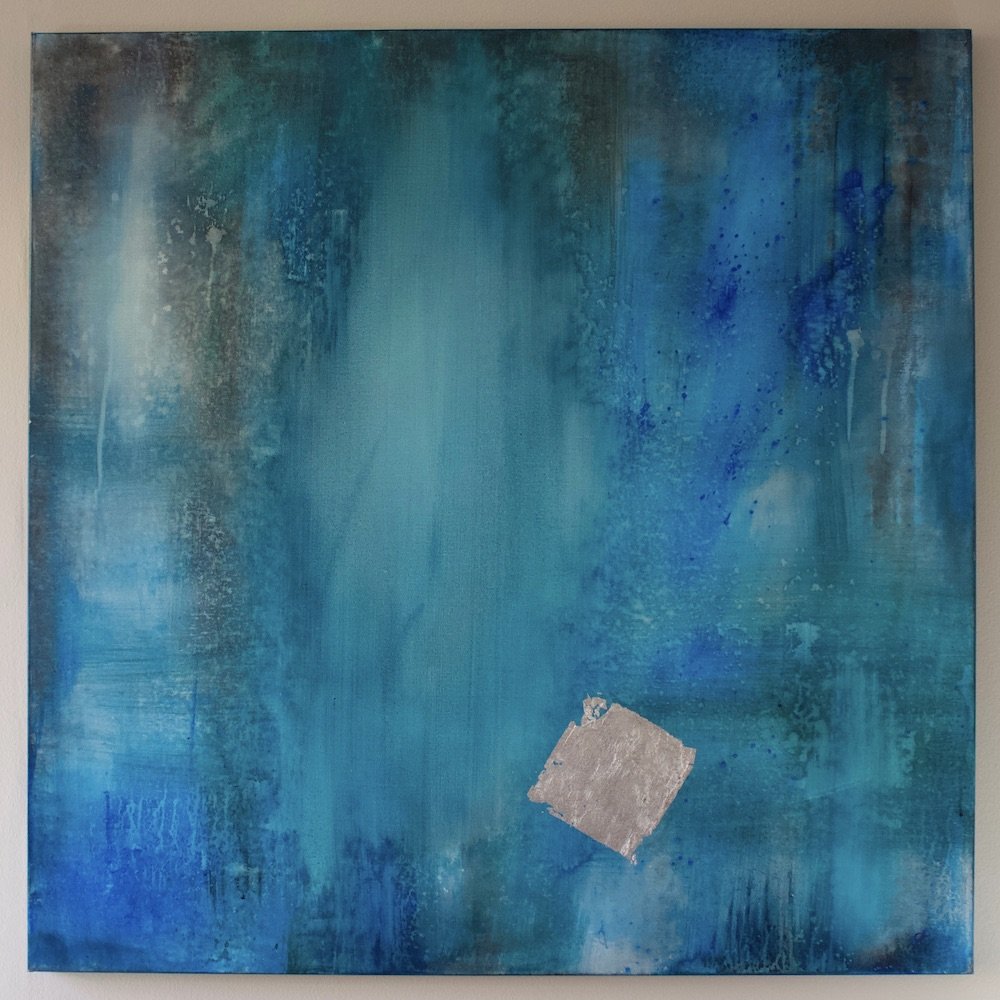Art, God, and Water: An Interview with Artist David Krilov
Artist Dave Krilov loans his abstract paintings to CCCRD to add a calming, introspective presence to our counseling rooms. Read our interview with Dave on his artistic approach, the interplay of art and faith, and how art has the power to transform walls — in the world and in our hearts.
Join Dave’s Art Class – February 2024
Experience the joy of art, explore new horizons, and unlock abstract art techniques with Dave Krilov’s class at the Medford Arts Center.
Thursdays in February | 6:30pm-8:30pm | Learn more at Medford Arts Center
Can you tell us about yourself?
I’m an artist in various mediums with a background in ministry. My first pastoral ministry experiences were with a mentor who had counseling training. His influence taught me to look at the heart and not just behavioral changes, being aware of identity and the “why” behind our behaviors—those types of soul issues.
At one point in my pastoral ministry, I was trying to hold things together on my own, and I just couldn't do it. It led me to a place of depression. I couldn't get out of bed, and I never thought something like that would happen to me. It was humbling, and it made me do a lot of soul work that I needed to do.
With the guidance of key people in my life, I worked through a lot of my own deep crud and also saw more clearly who I am in Christ, relying on the Holy Spirit and not trying to rely on my own performance or control, things like that. Basically, I learned that you can't lead people if you're not in a healthy place yourself. People are always growing and healing, of course. But you need to do that work in yourself.
All of this has influenced my work as an artist. I try to use art to help people. Art has the power to change things—it can transform a wall or a space. In a similar way, I hope to help people transform their internal “walls” and hopefully “unstuck” themselves that way.
Much of your work depicts water in various forms. Can you describe the transformative power of water and art?
I’ve held to the slogan that I want to help people transform their walls. What I mean by that is literal on one hand—obviously, hanging a painting in your house changes it. And on the other hand, I like to think about internal walls: What am I telling myself? What are the things that I'm talking to myself about? What are the thoughts that come into my mind? Those things that stop us from actually realizing who we are in Christ. We need to be transformed.
I discovered a book called Blue Mind by Wallace Nichols about the effect of just being in or near water and how it can have a calming and peaceful effect. That has always been the case for me—I grew up going to the ocean, I love to surf and paddleboard. Being on the water gives me a sense of well-being.
So, I wanted to combine water and art as a way to depict what is meaningful to me and to provide a calming, positive expression for others. I like how abstract art leaves the viewer to use their imagination and maybe even tap into areas of the brain that they have not thought about or maybe memories or soul issues or things like that. Hopefully, my art can be part of transforming people.
Describe your techniques and approach to art.
I like to combine a lot of different techniques. I make mostly abstract art with water and acrylic paint. Sometimes, I'll just let the water do its own work and I won’t even apply a paintbrush to it. I do a layer and let it dry, I'll do another and just move the canvas around and let the water take its effect. Sometimes, I will use brushstrokes to create a semi-abstract view of a landscape or a deep horizon.
How do art and faith interplay? Do you make “Christian” art?
I want to be accessible to all types of people, so my art is not something that only Christians can look at and find beneficial. I hope anybody can find beauty in it. But I think for the Christian, you're able to go on a deeper level with it.
All throughout Scripture, the theme of water symbolizes a lot of different things. In Genesis 1, water is looked at as disorder because the earth was “formless and void.” You see the Holy Spirit hovering over it and then bringing creation out of that. A lot of Genesis 1 and 2 is God bringing order to disorder. And then, obviously, in Genesis 3, we see disorder come back because of the fall of man and sin.
So you see water in the sense of disorder and creation as an act of God bringing order. But you also see water as a symbol for life and peace, that type of peace that God brings within us. Think of Psalm 23: “The Lord is my shepherd, I shall not want. He leads me beside still waters.” The waters are stilled, they are at peace, they're in their proper order.
I see Jesus saying the same thing: “Anyone who thirsts can come to me, and out of him will flow streams of living water.” Not only will he bring the peace that our heart desires between us and God and between us and others, but it also allows peace to flow out of us. We can bring that same life to other people through His Spirit working through our spirit.
In a sense, that's how I connect art and faith together. The artist Makoto Fujimura writes a lot about this from a Christian perspective—how God is a creator. He's an artist. He's created all this beauty, and when we create beauty in art, we are co-creating with God. We’re just tapping into who God made us to be.
I think, as Christians, a lot of times we think, “Well, I have to do this, do that, do this…” But why can’t I just be with God and enjoy God in the act of whatever I am doing? Art often leans toward that side of being with God rather than doing for him, and that ends up leading to doing something for someone else.
What do you hope for those who view your work in our offices?
I do wonder what people think or feel as they see my work. With the work of therapy, I wonder if people are looking at things in new ways as they come in and see the paintings. I hope that as people pass by it, or as they’ve been talking with a counselor, that maybe the art will prompt them to think about things a little bit differently. Maybe it helps them to rewrite the story that they’ve been telling about themselves, who they are, the character they have been playing, or a lie they’ve been telling. Maybe it inspires a new vision of who they could be and who they are.
How do you gain inspiration for art?
Sometimes, it’s something in my mind already, or like a picture I took at the beach or something I see in a surfer’s journal. A lot of the time, I am looking at the colors and how warm and cool colors complement each other. Or maybe I’ll see someone else’s work of art, and that will make me think of something else.
Also, what you start with often doesn’t look like what you thought it would be in the end. Sometimes, it seems like the work of art is going in a different direction, so I’ll switch it up. That’s a big lesson I’ve learned in life, too—learning to pivot. Whenever I’m painting something, it reminds me, this is not what I thought life would look like. I had a different vision. But you pivot, and you trust God with the rest, with the results. It’s the same with painting.




